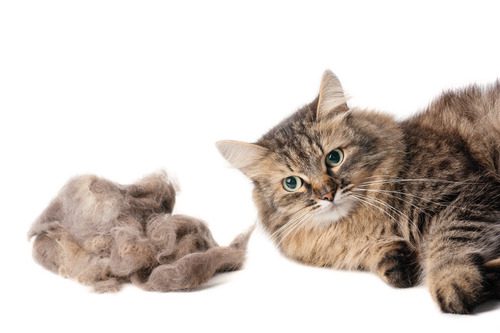Is Your Cat’s Hairball Normal? When to Call the Vet and What to Do

If you’ve ever heard your cat hacking, then watched them spit up a damp clump of fur, you’ve likely wondered: is that normal? While occasional hairballs are expected in cats, especially long-haired breeds, frequent or excessive hairballs can point to something more concerning. So how do you know when a hairball is just part of your cat’s routine grooming, and when it’s time to call Yalesville Veterinary Hospital? This blog covers everything you need to know about cat hairballs: what causes them, when they might indicate a problem, and how you can help reduce them.
What Causes a Cat Hairball?
Hairballs are the result of your cat’s natural grooming behavior. As your cat grooms, tiny, hook-like structures on their tongue catch loose hair, which is then swallowed. While most of that hair passes through the digestive tract without issue, some of it can stay behind and form a hairball in the stomach.
This is more common in long-haired cats like Persians and Maine Coons, but short-haired cats can also develop hairballs especially if they groom more than average. Shedding, seasonal coat changes, and stress grooming can all increase the likelihood of a cat hairball forming. Most cats will eventually vomit the hairball, often accompanied by a hacking or gagging noise, but not always.
Why Some Cats Get More Hairballs Than Others
Cats that shed heavily, have longer coats, or groom compulsively tend to develop more hairballs. Age can also play a role. Older cats may groom more frequently and thoroughly than younger cats, resulting in increased hair ingestion. Health conditions like skin allergies or parasites may also cause your cat to lick excessively, leading to more swallowed hair.
How Often Is Too Often for a Cat Hairball?
Many cats will cough up a hairball once every week or two, and this is generally considered normal. However, if your cat is vomiting hairballs more than once a week, or if the process seems painful or prolonged, it may be time to talk to your veterinarian. Frequent cat hairballs can indicate an underlying gastrointestinal issue or even a blockage. When hair can’t be passed through the digestive system, it may lead to serious complications that require medical attention. At Yalesville Veterinary Hospital, our team can help determine whether your cat’s hairball habits are typical or a sign of something more.
Hairballs vs. Vomiting: What’s the Difference?
It’s important to distinguish between hairballs and other types of vomiting. A typical cat hairball looks like a tube-shaped wad of wet hair. Vomiting, on the other hand, usually involves food, bile, or foam. If your cat is bringing up liquid without any visible hair or is vomiting multiple times a week, don’t assume it’s just a hairball. Persistent vomiting may require diagnostic testing to identify the cause.
When Should You Call Your Vet About a Cat Hairball?
While most cat hairballs are harmless, certain signs should prompt a call to your veterinarian. If your cat displays any of the following symptoms, it’s time to schedule an exam at Yalesville Veterinary Hospital:
- Repeated unproductive gagging or retching
- Loss of appetite
- Lethargy
- Constipation or diarrhea
- Bloated abdomen
- Frequent vomiting without hairball production
These symptoms could suggest that a hairball is stuck in the digestive tract or that your cat is dealing with another medical issue. Acting early can help prevent more serious complications.
Potential Complications from Cat Hairballs
In rare cases, hairballs can cause intestinal blockages that require surgery to remove. A blockage can prevent your cat from eating or using the litter box and may cause visible discomfort. If your cat is trying to vomit but nothing comes up, or if you notice weight loss and behavior changes, don’t wait to call us at (203) 265-1646 or book an appointment online today.
How Grooming Habits Affect Cat Hairball Frequency
Your cat’s grooming routine is directly tied to how often they experience hairballs. Regular brushing can remove loose hair before your cat has a chance to swallow it. Not only does this cut down on the amount of hair ingested, but it also helps you monitor your cat’s coat health and identify any skin issues early. Even short-haired cats benefit from brushing a few times per week, while long-haired cats may need daily grooming to stay ahead of shedding. Grooming isn’t just about hairball prevention. It’s a great way to bond with your cat and support their overall comfort and cleanliness.
Stress and Overgrooming
Cats that feel anxious or bored may lick themselves excessively, leading to more hair ingestion and more frequent hairballs. If your cat is grooming to the point of bald patches or shows signs of anxiety, such as hiding or vocalizing more than usual, let your vet know. Managing stress at home can go a long way toward reducing both hairballs and behavioral issues.
What Diet Has to Do with Cat Hairballs
Diet plays a key role in your cat’s ability to process and pass hair through the digestive tract. It’s worth noting that the fiber content and moisture levels in your cat’s food can influence hairball frequency. If your cat is experiencing frequent hairballs, your veterinarian may recommend changes to their diet based on their individual needs. These changes could support healthy digestion and help move ingested hair more easily through the body.
Signs Your Cat’s Food May Not Be Helping
Pay attention to any patterns between meals and hairball production. If you’ve recently switched foods and notice an increase in hairballs or vomiting, share this with your veterinarian. Diet-related concerns are often manageable with the right guidance.
How Indoor Living Can Increase Cat Hairballs
Indoor cats tend to groom more simply because they’re less stimulated by outdoor activities and environmental changes. With fewer distractions, grooming becomes a bigger part of the day and that leads to more hair ingestion. While indoor cats generally live longer, healthier lives, their environment can contribute to hairball problems if grooming isn’t balanced with exercise, enrichment, and regular brushing. Adding new toys, climbing towers, or scheduled playtime can help reduce grooming frequency and improve overall well-being.
Environmental Enrichment Tips
Introduce window perches, puzzle feeders, and rotating toys to keep your cat mentally and physically engaged. A more stimulating environment helps redirect focus from grooming to play and exploration.
Know What’s Normal for Your Cat and Act on Changes
The occasional cat hairball is typically nothing to worry about, but changes in frequency, appearance, or your cat’s behavior should never be ignored. Whether your cat has started coughing up hairballs more often or is struggling to bring one up, it’s worth having them checked by your veterinarian. At Yalesville Veterinary Hospital, we’re here to help you understand what’s going on with your cat and provide the care they need. Call us at (203) 265-1646 or book an appointment online today if you have questions about your cat’s grooming habits or digestive health.
